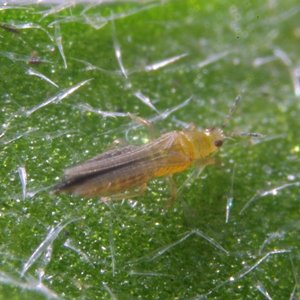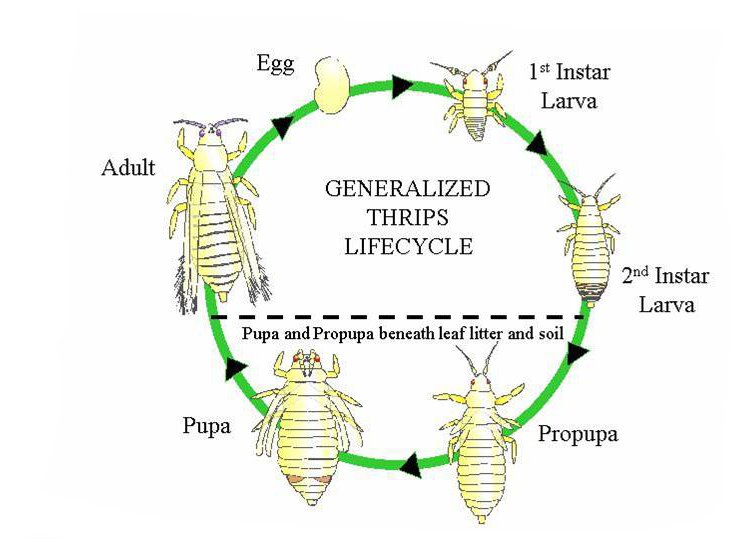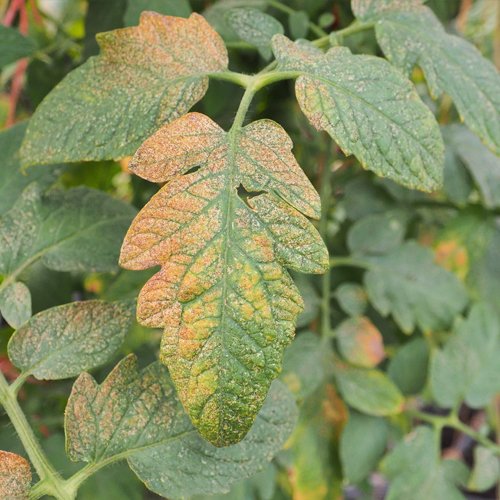
Source
Thrips are very small insects of 1 to 1.5 mm long, when they are in adult stage, dark in color and have a buccal scraper apparatus with which they pierce and tear the vegetal tissues, this allows them to absorb the cellular juices with the that feed
In juvenile stages, the larvae or nymphs are smaller, yellow and remain predominantly on the back of the leaves.

Source
When thrips are present, small whitish spots (empty cells) appear on the leaves of the plant which then turn yellowish, brown and even reddish. For this reason, heavily affected crops have silvery or gray leaves and then turn tanned. As a consequence of these injuries the water loss increases and in the dry season the crops wither faster; They are also a possible pathway for the entry of disease-causing agents.
Symptoms of crops infested by THRIPS
Direct damage, by scraping tissue from the adult insect increases the water loss of the plants and, under drought conditions of the soil, they dehydrate and wither more. With large amounts of thrips per leaf (40-50), they age prematurely and can fall from the plant.

Source
However, the real damage that influences crop performance is caused by nymphs. When they remain three weeks or more feeding on the underside of the leaf, they destroy the waxy layer that the plant produces to protect itself from dehydration, which increases the rate of transpiration and the loss of water within the plant tissue.
There is also a disorder in the stomatal opening with which the damage is even greater. The consequence is the premature aging of the leaves and their anticipated fall.
Damage caused by the wounds caused, "the wounds caused in the leaves can be a way of entry of disease-causing agents (fungi, viruses, bacteria)
Biological, physical and environmental factors facilitate the spread of the plague
The hydric stress caused by the drought allows the rapid increase of populations by favoring the development of thrips in a pseudopupa state in the soil. Upon successful completion of this phase, adult insects emerge that then disperse throughout the crop.
The wind is the main factor of dispersion of adults. By themselves they have a low capacity of flight, but the drag by the wind transports them to considerable distances within the batch of origin and towards other fields.
Thrips are first detected in areas of soil with lower fertility or soils where plants suffer more from water stress. The edges of the lots, with soils more compacted and degraded by the passage of machinery, are the first to be affected by this pest. Infestations also occur in the internal areas in patches of low fertility or poor water retention.
Preventive measures to avoid thrips in crops
Although rotations with grasses cause the local infestation to be reduced, the adults dragged by the wind will still colonize the crop regardless of its predecessor.
It is necessary to make a quick and complete treatment to the crop, later make a constant observation to avoid new sources of propagation.
Measures to control and eradicate thrips in our crops
The chemical control: it is the most used method, the innovations in products that act by penetration in the leaf of the leaf, offer technologies that manage to 'translaminar' to the opposite side, where are the nymphs that cause the greatest damages, we can find in the market effective products for thrips control such as Abamectin, which is a very effective and powerful acaricide, we must take precautions when using it (follow the manufacturer's instructions) it should be used at dusk when it is not sunny and other measures must be taken, all must come in the instructions, but if it is of quality with use once they will end up with the red spider.
Many agricultural producers use chemical products, due to the rapid action of these products, but we make an error with their use, because, in their application on crops, we are also killing the natural enemies that help us to maintain biological control in these plantations, so it is advisable to take preventive measures in crops to prevent the entrance of thrips in our crops.
Natural controls:
You can use adhesive traps when it comes to attracting and catching thrips. They are the most attracted by blue traps, which you can use by hanging them around the infected plants. It can gently shake the foliage to dislodge the thrips, causing them to rise and stick to the adhesive. This method does not use pesticides, represents a very small threat to other wild animals and is relatively resistant to weathering. However, it will require changing the tape after having captured a large amount of thrips.
In general, we recommend that you do not immediately jump to an aggressive chemical solution unless circumstances justify it; The damage that thrips have already caused to your plants will not disappear, so the best thing you can do is make sure that they are protected from that moment, do not damage them even more with the use of aggressive chemicals or, indirectly, through the disappearance of beneficial insects.
Natural methods to prevent the entry of thrips in crops
The best thing is to prevent, in this way we avoid that our plants are attacked by the thrips and any other plague;
To avoid thrips during the growth phase we can use a biological preventive insecticide composed of extracts of Neem oil. Neem oil a natural and biological product that is extracted from the neem tree, effective for almost all pests, very good for red spider, as long as you get it quality which is not always easy and not even buying the most expensive you make sure it's good. It is said that it can be used radicularly and that the roots could take the neem and if a plague eats from that plant it would have an effect. Other people say that this does not happen, I could not say yes or no, but if you use it directly on the plague, it works.
It should be used mixed with water with a pH not higher than 7 and with some potassium soap that serves as a humectant, sometimes the neem comes already with soap, it is noted because it has foam. It is dosed according to the manufacturer because it can have different concentration.
The extract of pyrethrum, very powerful natural product that kills most pests by contact, very effective with the white fly, biodegradable and the sun removes it very quickly, so it should not be used before the sun because it I would eliminate very fast. Must be